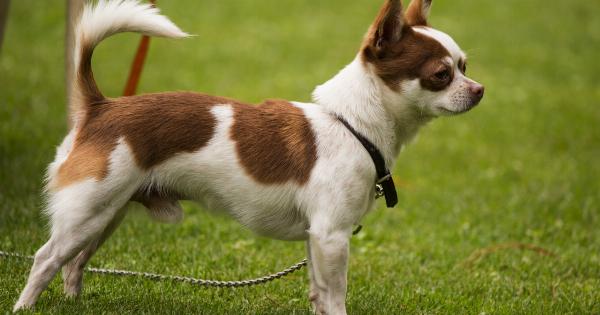Have you ever seen a dog chase its tail? It’s an amusing sight that many of us find entertaining.
However, did you know that this behavior may indicate an underlying issue or emotion that your canine friend is trying to convey? Here are thirty reasons why dogs chase their tails and the signs you should look out for:.
1. Playfulness
For most dogs, chasing their tails is simply a fun way to expend their energy. They may enjoy the feeling of motion and the challenge of trying to catch their own tail.
As long as your dog seems happy and healthy, there’s probably nothing to worry about.
2. Boredom
If your dog spends a lot of time alone or doesn’t get enough exercise, they may turn to tail chasing as a way to alleviate boredom.
This behavior can become compulsive if it becomes a habit, so make sure your dog is getting enough mental and physical stimulation.
3. Genetics
Some dog breeds are more prone to tail chasing than others. Terriers and other high-energy breeds, for instance, are known for their love of chasing things, including tails.
If your dog was bred for this type of behavior, they may show a natural inclination to indulge in it.
4. Stress
Dogs who are anxious or stressed may chase their tails as a way to self-soothe.
If you notice your dog exhibiting this behavior during times of stress, such as during a thunderstorm or when you have guests over, it’s important to address the underlying cause of their anxiety.
5. Attention-Seeking
Some dogs may chase their tails in order to get attention from their owners. If your dog starts tail chasing while you’re paying attention to something else, they may be trying to redirect your focus back to them.
6. Hunger
Some dogs may become obsessive about chasing their tails if they are hungry. If you notice your dog doing this after a long period without food, try feeding them more frequently or giving them small, frequent meals throughout the day.
7. Medical Issues
In some cases, tail chasing may be a sign of an underlying medical issue. Dogs who are experiencing pain or discomfort may try to relieve it by chasing their tail.
Similarly, dogs who have fleas or other skin irritations may chase their tail in an attempt to scratch it.
8. Fleas or Other Parasites
Fleas, ticks, and other parasites can cause a lot of discomfort for dogs. If your dog is chasing their tail excessively, check their skin for any signs of infestation and seek treatment from your veterinarian.
9. Allergies
Allergies are a common cause of skin irritation in dogs. If your dog is constantly scratching or biting at their tail, it may be a sign of an allergy to something in their environment, such as pollen or certain types of food.
Talk to your vet about getting your pet tested for allergies.
10. Nutritional Deficiencies
If your dog is not getting enough of certain nutrients in their diet, they may try to compensate by chasing their tail. Make sure your dog is getting a balanced diet that meets all of their nutritional needs.
11. Compulsive Behavior
Sometimes dogs may chase their tails compulsively, even to the point of causing injury. This may be a sign of an underlying condition, such as obsessive-compulsive disorder (OCD), and should be addressed with a qualified veterinarian.
12. Lack of Socialization
Dogs who have not been properly socialized may engage in tail chasing as a result of fear or anxiety. If your puppy was not exposed to a variety of people, animals, and environments early on, they may be more prone to developing social anxiety.
13. Separation Anxiety
Dogs who suffer from separation anxiety may chase their tails as a way to cope with the stress of being alone.
If your dog shows signs of separation anxiety, such as barking, destructiveness, or urinating in the house, seek help from a professional behaviorist or vet.
14. Hormonal Imbalances
Hormonal imbalances, such as thyroid problems, can affect your dog’s behavior and cause them to become obsessed with tail chasing. If you suspect your dog may have a hormonal imbalance, consult with your vet.
15. Puppies
Puppies are still learning about their bodies and may chase their tails simply because they are curious. This behavior often fades as they mature and become more accustomed to their surroundings.
16. Envy
If your dog sees another dog chasing their tail or engaging in a fun activity, they may get jealous and want to join in on the action. This behavior is perfectly normal and shouldn’t be cause for concern unless it becomes obsessive.
17. Fear or Aggression
In some cases, a dog may chase their tail as a sign of aggression or fear. If your dog seems to be doing this as a way to intimidate others or because they are afraid, you should seek professional help to address the underlying issue.
18. Lack of Activity
If your dog is not getting enough exercise or stimulation, they may chase their tail as a way to release pent-up energy. Make sure your dog is getting enough daily exercise and play time to keep them happy and healthy.
19. Digestive Issues
Dogs who are experiencing digestive problems may try to alleviate their discomfort by chasing their tail. If you notice your dog exhibiting other signs of digestive issues, such as vomiting or diarrhea, seek veterinary care.
20. Worms
Intestinal parasites, such as worms, can cause a lot of discomfort for dogs. If you notice your dog chasing their tail excessively and experiencing other symptoms such as weight loss or lethargy, seek medical attention right away.
21. Dementia
Senior dogs may exhibit tail chasing as a result of neurological issues such as dementia. If you notice your elderly dog showing signs of confusion or disorientation, talk to your vet about ways to manage their condition.
22. Injury
If your dog has sustained an injury to their tail or spinal cord, they may chase their tail as a way to alleviate the pain. If you notice your dog exhibiting other signs of injury such as limping or whining, seek veterinary care right away.
23. Seizures
In some cases, dogs may chase their tails as a result of seizures or other neurological issues. If you notice your dog exhibiting strange behavior or experiencing seizures, seek veterinary care right away.
24. Sleep Disorders
Dogs who suffer from sleep disorders such as sleep apnea or insomnia may chase their tails as a way to cope with their condition.
If you notice your dog exhibiting other signs of sleep disorders, such as snoring or restlessness, talk to your vet about ways to manage their condition.
25. Eye Issues
Dogs who are experiencing eye problems may try to alleviate their discomfort by chasing their tail. If you notice your dog rubbing their eyes or exhibiting signs of eye discomfort such as redness or discharge, seek veterinary care.
26. Ear Infections
Ear infections can cause a lot of discomfort for dogs and may make them more prone to tail chasing as a way to alleviate their pain. If you notice your dog exhibiting other signs of ear infections, such as discharge or odor, seek veterinary care.
27. Skin Irritations
If your dog is experiencing skin irritations such as rashes, hives, or dry skin, they may chase their tail as a way to alleviate the discomfort. Talk to your vet about ways to manage your dog’s skin issues.
28. Teeth Issues
Dogs who are experiencing dental problems may try to alleviate their pain by chasing their tail. If you notice your dog having trouble eating or exhibiting other signs of dental issues such as bleeding gums or bad breath, seek veterinary care.
29. Attention Disorder
In some cases, tail chasing may be a sign of an attention disorder such as attention-deficit/hyperactivity disorder (ADHD).
If you notice your dog is incapable of focusing and this reflects in its body movements, seek veterinary assistance to properly manage the situation.
30. Just because they can
Sometimes dogs chase their own tails just because they can. It’s a fun activity that provides a good workout and helps them blow off some steam. In most cases, there’s nothing wrong with this type of tail chasing.
But, sign of any other symptom coupled with tail chasing should be attended to.
Conclusion
As you can see, there are numerous reasons why dogs might chase their tails. Generally, a happy, healthy dog who chases their tail occasionally is nothing to be concerned about.
However, if this behavior becomes obsessive or is accompanied by other symptoms, it’s important to seek veterinary care to determine the underlying cause and manage the situation effectively. By paying attention to your dog’s behavior and needs, you can help ensure they live a long, healthy, and happy life!.






























